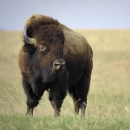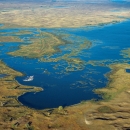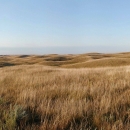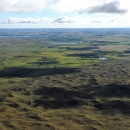Visit Us
North Platte National Wildlife Refuge is open sunrise to sunset. For questions, please call the Refuge office at 308-783-2477.
The Refuge office is open Monday - Friday from 8:00am to 4:30pm except for Federal Holidays.
Boasting abundant wildlife, the North Platte National Wildlife Refuge units contain a mixture of native prairie and woodland habitat. Whether the Refuge unit is surrounded by water (Stateline Island) or bordering a reservoir (Lake Alice, Lake Minatare, and Winters Creek), riparian riparian
Definition of riparian habitat or riparian areas.
Learn more about riparian habitat is a key feature of this Refuge.
Water bodies attract an abundance of waterfowl and shorebirds, and the riparian edges support songbirds, raptors, and a variety of other birds. Additionally, 21 mammals including both mule and white-tailed deer, can be seen throughout the year. During the warmer months, 17 species of reptiles and amphibians may also be observed.
Activities
North Platte National Wildlife Refuge provides numerous recreation opportunities to thousands of visitors each year. People enjoy viewing the unique geology and diverse wildlife, whether boating, driving, or hiking!
Other Facilities in the Complex
North Platte National Wildlife Refuge is administered as part of the Sandhills National Wildlife Refuge Complex which includes Fort Niobrara NWR, Valentine NWR, Crescent Lake NWR, Lacreek NWR and John W. and Louise Seier NWR.
Lacreek National Wildlife Refuge lies in the shallow Lake Creek valley on the northern edge of the Nebraska Sandhills and includes 16,410 acres of native sandhills, sub-irrigated meadows, impounded fresh water marshes, and tall and mixed grass prairie uplands. The Refuge serves as an important staging area for migrating waterfowl, sandhill cranes, shorebirds, and neotropical migrants. Providing critical wintering habitat for the high plains trumpeter swan population is a primary goal.
Fort Niobrara National Wildlife Refuge was once a frontier military fort, supports an exceptional diversity of plants and wildlife representative of the northern Great Plains and geographic regions east, west, north, and south of here. In the early 1900s, President Theodore Roosevelt and private conservation organizations, such as the National Audubon Society and American Bison Society, were becoming increasingly concerned with the exploitation of wildlife and their habitats on the Great Plains and elsewhere. As a result, an Executive Order was signed on January 11, 1912, establishing Fort Niobrara as a "preserve and breeding ground for native birds." Later that year, the Refuge's purpose was expanded to include the conservation of bison and elk herds representative of those that once roamed the Great Plains.
Valentine National Wildlife Refuge is 71,516 acres and is located in the Sandhills of north-central Nebraska. The Refuge is a unique and ecologically important component of the National Wildlife Refuge System (System) which includes more than 566 National Wildlife Refuges spanning approximately 100 million acres of lands and 750 million acres of oceans in the United States. The native grass prairie and wetlands found here support a diversity of wildlife. Little has changed from historic times. The Refuge was established by Congress in 1935 “as a breeding ground for migratory birds and other wildlife.” The Refuge is home to 270 species of birds, 59 species of mammals, and 22 species of reptiles and amphibians.
Crescent Lake National Wildlife Refuge lies on the southwestern edge of the Nebraska Sandhills, the largest sand dune in the Western Hemisphere. The Sandhills are characterized by rolling, vegetated hills and interdunal valleys. These habitats on the Refuge are interspersed with 21 wetland complexes—shallow lakes, marshes, seasonal wetlands, wet meadows, and a small stream. Wildlife diversity, except large ungulates and their predators, is relatively unchanged since early settlement.
John W. and Louise Seier National Wildlife Refuge is found in north-central Nebraska, as a sanctuary among the Sandhills. The Sandhills region is the largest remaining tract of mid and tall grass prairie in North America. The Seier Ranch was originally homesteaded by John and Louise Seier’s grandparents in the mid-1800's. John and Louise Seier donated, their 2,400 acre working cattle ranch to U.S. Fish and Wildlife Service in October of 1999. Because the Refuge is so new to the System, it remains closed to the public at this time. There is no projected date for the opening of the Refuge, however, a date will be established upon the completion of a management plan.
Rules and Policies
There are lots of fun, interesting, and educational things you can do and enjoy on the North Platte National Wildlife Refuge. For questions regarding rules or regulations regarding a specific activity, please check with the Refuge office before participating in that activity. Be safe and enjoy the outdoors!
General Regulations
- Off road/trail vehicle use is prohibited. Motor vehicles may be operated on county roads and mowed trails only.
- Parking is permitted adjacent to open roads or trails (within one vehicle length of the road or trail) or in mowed parking areas only.
- Gates must be left as they are found opened or closed.
- Pets must be confined to vehicles or on a leash.
- Possession of alcohol is prohibited on North Platte National Wildlife Refuge.
- Limited hunting is permitted on the Lake Alice Unit.
- For state fishing regulations, see the Nebraska Game and Parks Commission Fishing Guide.
Lake Alice Unit
- The public is invited to participate in permitted activities between January 15 and October 14 during daylight hours only. From October 15 through January 14, the unit is closed to all public entry in order to provide an undisturbed sanctuary during the critical migration season.
- The west half of the unit may be closed to all public entry to provide an undisturbed sanctuary if nesting Bald Eagles are present.
- The east half is open to licensed motorized vehicles on authorized trails only.
- To view a map of Lake Alice public use opportunities, click here (File size: 91 KB). The map will open in a separate window.
Lake Minatare Unit
- This unit is open for permitted activities from January 15 through October 14 during daylight hours.
- Adjoining Refuge land is the Lake Minatare State Recreation Area, which is managed by the Nebraska Game and Parks Commission. Information regarding use of the State Recreation Area may be obtained at the park headquarters, which is located on Lighthouse Point Road.
- From October 15 through January 14, the entire area is closed to all public entry to provide an undisturbed sanctuary during the fall migration period.
Winters Creek Lake Unit
- The northeastern upland sites, along with the north portion of the lake, are closed to all public entry to provide an undisturbed sanctuary of land and water for a variety of wildlife species. The remaining portion of the unit is open for permitted activities from January 15 through October 14 during daylight hours.
- Boats may be operated by electric motors or hand power only.
- You are responsible for complying with all State fishing regulations.
While the Winters Creek Unit is managed by the U.S. Fish and Wildlife Service, its fishery is managed cooperatively with Nebraska Game and Parks Commission. To be effective and efficient in managing wildlife resources within our ecosystem, Federal and State agencies are working closely with each other, with non-governmental organizations, and with private individuals “to get the job done!” Winters Creek Lake is a good example of partnership in action.
Stateline Island Unit
- Located one mile south of Henry, Nebraska, this unit is open for permitted public use activities year-round during daylight hours only.
- National Historic Preservation Act of 1966
- National Wildlife Refuge System Administration Act
- National Wildlife Refuge System Improvement Act
- National Wildlife Refuge Volunteer Improvement Act
Locations













- The Refuge is open from sunrise to sunset.
- Roads throughout the Refuge are graveled and visitors must maintain the posted speed limit of 25 miles per hour.
- Parking is allowed in designated parking areas only.
Lodging is available in Scottsbluff, Nebraska, 8 miles southwest of the Refuge. Listings are available through the Scotts Bluff County website. Telephones, gas and supplies are available year-round in Scottsbluff.
For questions about recreation, please contact LINK the Refuge office.
Lake Minatare and Winters Creek:
From US Highway 26, travel north on Sugar Factory Road approximately 5 miles to Lake Minatare Road. Turn east and travel approximately 6 miles to Stonegate Road. Turn north on Stonegate, the entrance to Lake Minatare is approximately 2 miles; the Winters Creek entrance is just beyond on the opposite side of the road.
Lake Alice:
From US Highway 26, travel north on Sugar Factory Road to County Road C (approximately 7 miles). Turn east on County Road C approximately 2 miles to the Lake Alice entrance.
Stateline Island:
From U.S. Highway 26 at Henry, Nebraska, travel south on Holloway Road approximately 1 mile to the entrance and parking area.
View a general location map of the Refuge here in Google Map or enter your starting address in Google maps for directions to North Platte National Wildlife Refuge Office Complex.






